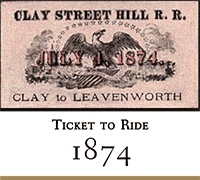Cable Cars
Locomotive Landmark

THE FINISHED PROTOTYPE for a cable car, with a driver's cab at either end, appeared on the California Street line in 1889.
The original cable cars were tiny trams powered by a patented grip that alternately holds, and releases, a continuously moving steel cable which is slotted under the street, and parallel to the tracks. Power to activate these blocks-long cables is supplied by huge drums housed at nearby power stations along the route.
The tram operator is stationed in the forward part of the car and when he employs the grip in order to grab and hold onto the moving cable, the tram then also moves and at the same speed. When the grip is subsequently released from the moving cables, the tram becomes stationery, even if stopped on a hill, using an invention of gear technology that prevents slippage. This same technology can also be found in elevator cars to prevent them from falling should the steel cable snap.
To this day, each cable car is manned by two drivers: the tram operator, who is officiall called the gripman, and the conductor. The gripman actually controls two levers and these are held in position by ratchets. One lever is used to grip onto, or relase from, the moving cable. The other lever is a hand brake. Should he feel it necessary the gripman also has a foot brake, to achieve and ensure a maximum feeling of control. The gripman is aided by the conductor, should the need arise, and whose then job it will be to stand at the very back where another hand brake is located.
In 1955, San Francisco decided to renovate the entire cable car railway system and fold it into a municipal envelope, and only the Powell and California lines were left intact; all other systems faded into history. The Powell Street line begins at Market and runs northward up a steep grade to Nob Hill, crossing the California Street line "on the hump" where it then drops down along swanky Mason, Washington and Jackson Streets over to and then straight down Hyde, ending up at Fisherman's Wharf.
The California Street line starts one block in from the Bay at the Embarcadero, trots by the financial and commercial districts before climbing past Old St Mary's Church on its way up to Nob Hill and then straight down to end at Highway 101, known by the locals as Van Ness Avenue.
In 1917, Andrew Hallidie was posthumously remembered by having an innovative building named after him. The Hallidie Building at 130 Sutter Street in San Francisco, by Willis Polk, w/ a facade wall that was sheathed in glass and rising eight stories. It was the first structure in the United States to achieve this feat. In 2010, the Hallidie Building underwent a series of rehabilitations including repairing the balconies, fire escapes, cornices, and decorative sheet metal frieze panels, and repainting the facade in its orginal blue and gold. Today it is home to the American Institute of Architects.
Andrew Smith Hallidie was born in London on March 17, 1937. His father, Andrew Smith, was born in Dumfrieshire, Scotland, in 1798, and his mother, Julia Johnstone, was from Lockerbie. Young Andrew Smith adopted the surname Hallidie in honor of his godfather and uncle, Sir Andrew Hallidie, who had been physician to King William IV and to Queen Victoria. He died on April 24, 1900, in San Francisco. Six years later his cable car system would survive the Great Earthquake w/ repairable damage.
